

“Apple has several restrictions on cryptocurrency apps,” he said. Lammiman explained this decision was an attempt to play by Apple’s rules. The Stick圜oins themselves were bought in packs using standard in-app purchases. Sticky’s transactions were made using “Stick圜oin,” which is not a cryptocurrency. This prevented them from being copied and resold on other marketplaces like OpenSea, the company said. Users could also only sell items made in Sticky within Sticky, where the NFT images appear watermarked unless you own them.

The most recent version of the app allowed creators to mint “NFTs” on Sticky’s ledger. Sticky began to fundraise, Lammiman said. The revamped app began to gain traction around December 2021 and received positive feedback.

But it later redesigned to focus on NFTs when it couldn’t make the earlier model work financially. It’s also another indication of how Apple seems to be making decisions on the fly as it tries to address developers’ use of new technologies and terminologies.įor a while, at least, it seemed Sticky had found a loophole in Apple’s unspoken rules for NFT apps.Īs its name implies, Sticky began as a tool for creating stickers back in 2020. The removal serves as an interesting example of how Apple is deciding what’s permitted on the App Store and what’s not. The company also explained to users that its NFTs were “collectibles,” but not “securities, convertible currencies, or investments.” It was using a proprietary, private ledger, which it disclosed in the app’s App Store description. Sticky’s app had been operating in a hazy area, to be fair. It did not give Sticky time to make changes to the app before pulling it down, Lammiman said. But Apple eventually told Sticky that it was misleading to use the term “NFT” for digital collectibles than weren’t minted to a public blockchain. During this time, Apple approved over half a dozen updates to the app that used the term “NFT” in the same manner that ultimately led to the app’s removal. Lammiman created the mobile-native “NFT” marketplace app Sticky, which had been live on the App Store for several months before Apple removed it. One developer who experienced bumping up against the line first-hand is Alan Lammiman, founder of Daily Apps. But the lack of official guidelines around NFTs on iOS has made it hard for app developers to know where the line is in terms of what’s permitted and what’s not. Other NFT apps offer similar discovery features. The same goes for Rarible’s iOS app, which is described as an NFT browser for “viewing” blockchain collectibles. The company permitted NFT marketplace OpenSea to launch an app, but only for browsing NFTs - not for buying and selling them. Apple’s approach to NFT apps is still something of a gray area.


 0 kommentar(er)
0 kommentar(er)
